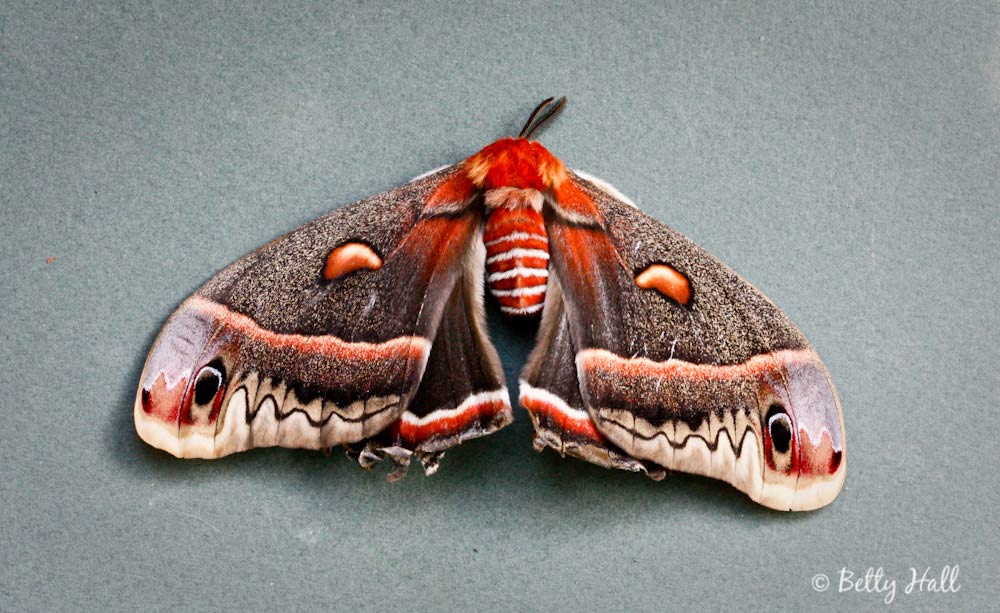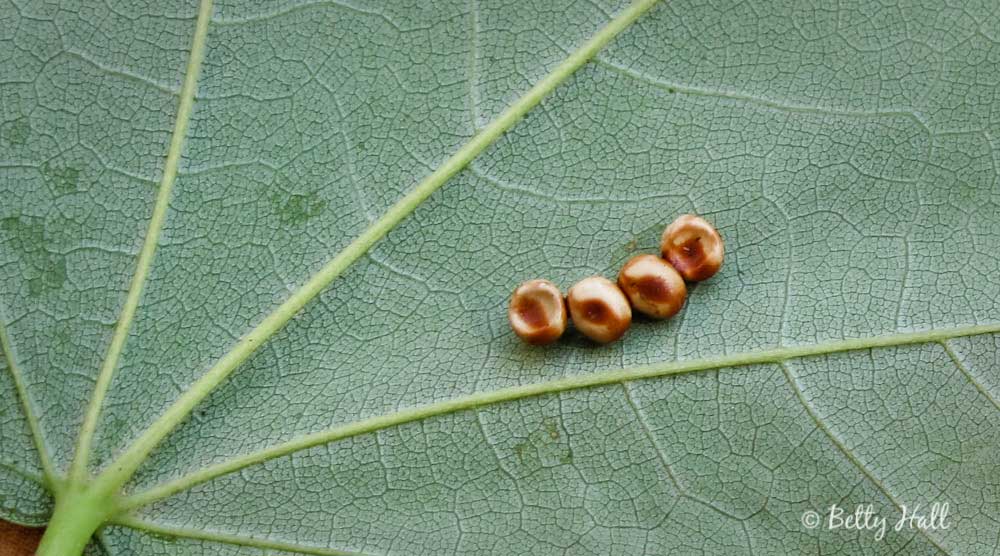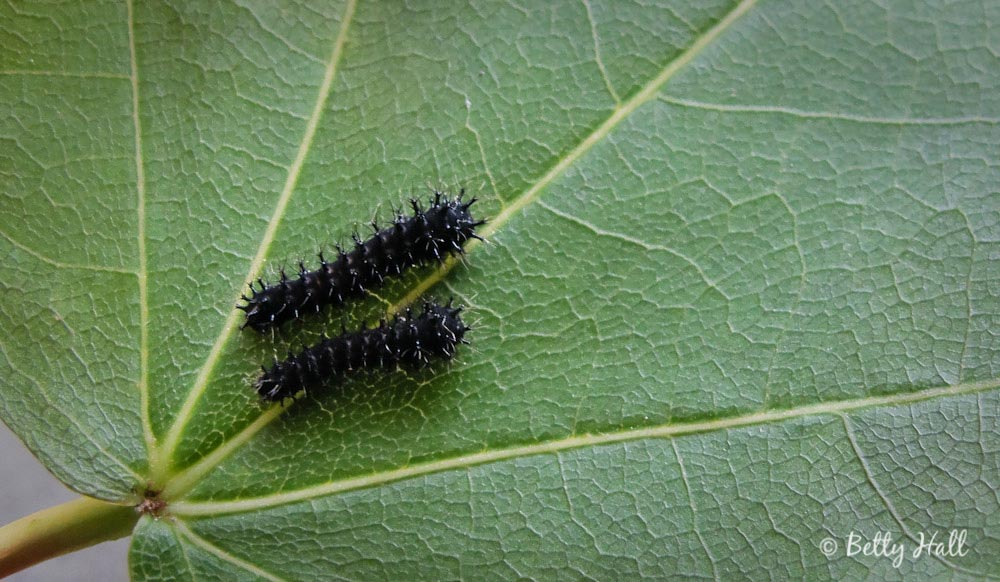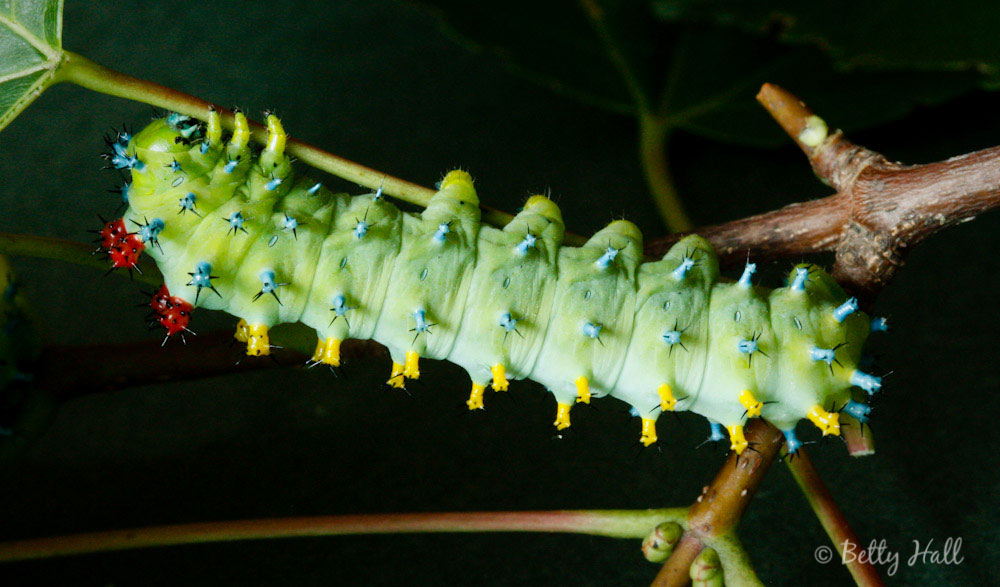My friend, Amanda Cawby, noticed something unusual in the road one night. Not sure what it was but afraid it would be run over, she stopped to pick it up. To her surprise, it was a Cecropia moth (Hyalophora cecropia), another of our large silkworm moths. Cecropicas typically have a wingspan of 4-6 inches.

The moth was barely alive and died soon after Amanda put it in a cigar box. She brought it to me and we noticed that before it died it had laid several eggs, each about 1/8″ in diameter.

We were doubtful the eggs would hatch. However, I placed them on red maple (Acer rubrum) leaves. About a week later I was delighted to find small black specks on the leaves. This is how they appeared at one week old.

The seven caterpillars are eating and growing rapidly. At five weeks, they are two inches long and quite a work of art.
 If all goes well, they will grow to four inches long before spinning a cocoon where they’ll spend the winter. It’s truly fascinating to watch them.
If all goes well, they will grow to four inches long before spinning a cocoon where they’ll spend the winter. It’s truly fascinating to watch them.


Betty – the photo of the adult moth is absolutely breathtaking. The incredible care in conserving the moth’s eggs and the hopeful, nurturing task of providing them with an appropriate environment is a nice respite from the news from the wider lens of the world. It is so nice to be reminded that the natural world thrives in the small quiet actions and spaces of the people who care about it . . .
Thanks for those kind words, Kathy. Connecting with nature is therapeutic for me and I find it quite satisfying to be able to share it with others that share my interest.
These are such a beautiful caterpillar and moth! We are raising 11 big ones right now on sweet gum leaves and they should be spinning cocoons very soon 🙂
Thanks for sharing, Judy. Eleven caterpillars! and I’m thinking close to four inches long? I can imagine they are going through a lot of sweet gum leaves right now. Here’s hoping we can both see them fly next summer.
Nature gives such beautiful gifts! I am so glad Amanda saw the Ceceopia and was able to stop and I am wondering if the laying of eggs is this moth’s final act signaling their role in life’s ever-cycling drama is over. Do you know? Also I am fascinated by the beatiful red, yellow and blue buds on the older
caterpillar. Do you have any information on their function?
Yes. Beth. The large silkworm moths do not have mouth parts so they do not feed. After they emerge they mate and the females lay eggs. As to the colorful “bumps”, I don’t know of any function. I think they’re quite ‘arty’ However, the color may help call attention to the little “spines” on top of them which might make other critters think twice before eating them. Actually the ‘spines’ look dangerous but they are quite touchable.
What a fascinating story…and a beautiful ending. Sara
Well, so far I agree, Sara. I hope they will all make successful cocoons. Then the real ending will come next summer when and if they emerge from their cocoons and fly away. My concern is getting them safely through the winter – keeping them cool and not letting the cocoons dry out.
Wow! That is so cool! You are indeed fortunate to have friends who share your passion!
I totally agree, Christine.
I LOVE YOU!!!!!! AND AMANDA TOO. THANK YOU SO MUCH FOR THE TIME AND ATTENTION TO DETAIL THIS PHOTOGRAPHY TOOK.
Thanks, Connie. It’s all much fun.
I was delighted to see this beautiful moth on your blog! I was enjoying our mutual friend Ann’s company yesterday during her visit to ON and we were talking about this moth. On May 21 here in Loretto,ON, the same moth caught my husbands attention while he was mowing the lawn. We got one good picture and thanks to the internet tracked down it’s name. As a textile enthusiast I was more than delighted it was a ‘Silk Moth’. Wishing your caterpillar babies all the best and looking forward to their emergence into the world next spring. I am so amazed at the brilliant colours on their bodies – thanks for your beautiful photography and loving care of these little beauties.
Good to hear from you Marsha and to think of you and Ann being together. I didn’t realize the Cecropia would be out in May and can imagine your and your husband’s delight in seeing it, getting a photo, and identifying it. The caterpillar babies are eating and growing, so I’m assuming all is well…so far. I appreciate your good wishes.
From the local Univ. of Guelph web site I found some info about Hyalophora cecropia in ON, and the moths emerge from their cocoons in May or June. Their photos are not near as lovely as yours!
http://www.uoguelph.ca/pdc/Factsheets/PDFs/097CecropiaMoth.pdf
Thanks, Marsha, for doing the extra research. I think of you as being considerably farther north and supposed it would be later for you than for us. Apparently that isn’t the case. Here’s hoping we both see them again next spring.
Betty, I sent a link to your site to a photographer I met through a friend. I know she will be impressed with your beautiful photography, as well as the research you do on those beautiful visitors to your yard.
Thank you, Sara. I appreciate.
Betty, What great photos. That is one pretty moth! Now you’ve given me the heads up to keep an eye on my red maple. Maybe I’ll be as lucky as you! Thanks for sharing.
Thanks, Loret. Do hope you can find one.
I’ve been trying tonight to get through a backlog of emails and was sure glad I did and didn’t miss these photos. What an amazing story! How fantastic those few eggs got saved and nurtured and made it to the caterpillar stage. I just love that colorful adult! What’s their status now?
Yes, Keli, it is an amazing story. The seven caterpillars all grew to be about 4 inches long. During the past two weeks each of them has enclosed itself in a silk cocoon where it will spend the winter. Here’s hoping they all emerge next June.